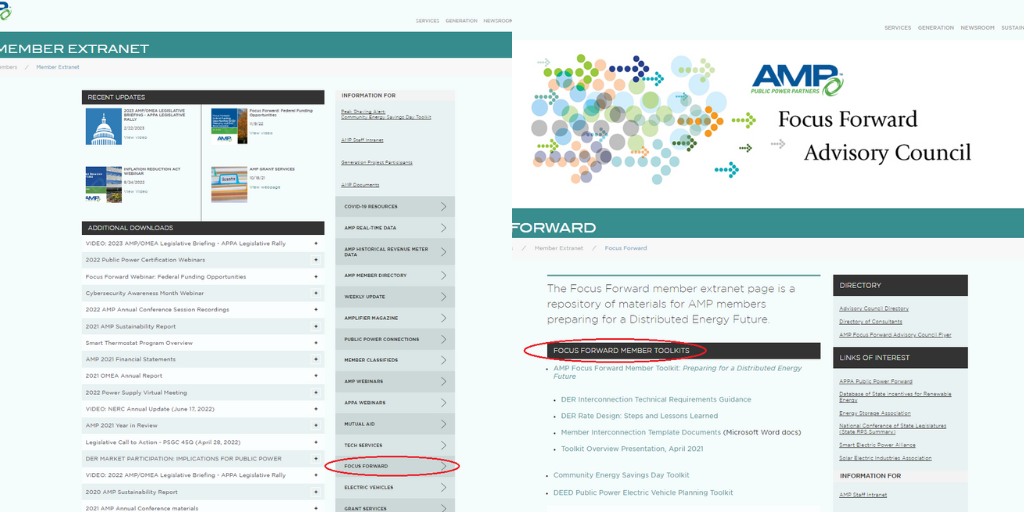Solar+Storage Guidance Document
3 min reada
a
March 2023
By Zachary Hoffman, manager of communications and publications
Throughout the last decade, the number of solar installations in the United States has been growing at a breakneck pace. According to analysis by the Solar Energy Industries Association (SEIA) and Wood Mackenzie, solar has an average annual growth rate of 33 percent and there are now more than 135 gigawatts (GW) of solar capacity installed in the U.S.
While this growth has been notable in the utility sector, increased growth in the number of residential, commercial and community solar installations has presented new challenges for many electric service providers. As of 2022, of the 135 GW of cumulative U.S. solar installations, residential installations made up more than 27 GW, commercial installations made up more than 16 GW and community solar made up 4 GW — together totaling more than one-third of all U.S. solar installations.

Focus Forward Member Toolkits are available exclusively to our member utilities on the Member Extranet (login required). The DER toolkit includes the DER Interconnection Technical Requirements Guidance document, DER Rate Design: Steps and Lessons Learned, Member Interconnection Templates. Other toolkits include the Community Energy Savings Day Toolkit and DEED Public Power Electric Vehicle Planning Toolkit. Once a member logs into the Member Extranet, click the Focus Forward link on the right. The Focus Forward Member Toolkits will be in the first section of the new page.
Similarly, residential and commercial battery storage installations are growing at an increasingly rapid pace. According to Wood Mackenzie residential energy storage installations have been hitting record levels. While far less common than rooftop solar, private energy storage installations will continue to become more common in the coming years and grow alongside their utility-scale counterparts.
Many AMP member utilities have yet to see a similar increase in the number of solar or solar+storage installations in their communities. In recognition of the likelihood that such projects will eventually impact member communities, AMP’s member-driven Focus Forward Advisory Council has asked AMP to study the issue. As a result, AMP partnered with POWER Engineers and created a guidance document as part of the Focus Forward Member Toolkit.
Available exclusively to AMP members at no cost, the Focus Forward Behind-the-Retail-Meter Distributed Energy Resource Interconnection Technical Requirements Guidance covers areas of major concern for public power utilities regarding customer-owned installations. The document can be used as a resource to aid in the safe interconnection of customer-owned solar, solar+storage and other distributed energy resource (DER) installations and to set guidelines on whether interconnection to the utility’s distribution system should be permitted.
The major sections of the guidance document include:
- Required studies — This section describes the studies that utilities should conduct prior to interconnection of solar, solar+storage, as well as other DER installations that are requesting to be interconnected with utility distribution systems. It does not address any studies that may be required by the transmission owner. This section also includes the screening requirements for a utility interconnection study as well as the requirements needed for a utility feasibility study; an arc-flash assessment, according to National Electrical Code (NEC) standards; and the process of a utility system impact study where interconnection is needed.
- Technical requirements — This section describes the minimum technical requirements utilities should require for DER interconnection to the distribution system. In addition to the technical requirements, this section outlines how all DER installations should adhere to applicable National Electrical Safety Code and NEC requirements.
- Design review and approval — This section covers the items needed for design review for all DER facilities, such as sight plans and electrical diagrams. It also provides guidance on the process of review, alterations and approval.
- General equipment and operating requirements — This section covers the necessary equipment and operating requirements to safely install and connect any DER facilities to the distribution system. It also identifies the related responsibilities of the utility and of the owner. This includes equipment requirements, operation and maintenance and safety.
Read the technical requirements document by accessing it on the Member Extranet and use it as a guide to establish rules and procedures for solar and solar+storage installations. It is most beneficial to have these plans in place before an installation begins.
In addition to the guidance document, the Focus Forward Advisory Council provides a number of other materials available in the Focus Forward Member Toolkit, including a “DER Rate Design: Steps and Lessons Learned,” member interconnection template documents and more. The toolkit is available here on the Member Extranet (login required).
If you have questions about the guidance document or solar+storage, or if you would like to participate in the Focus Forward Advisory Council, please contact Erin Miller, AMP assistant vice president of energy policy and sustainability, at [email protected].


